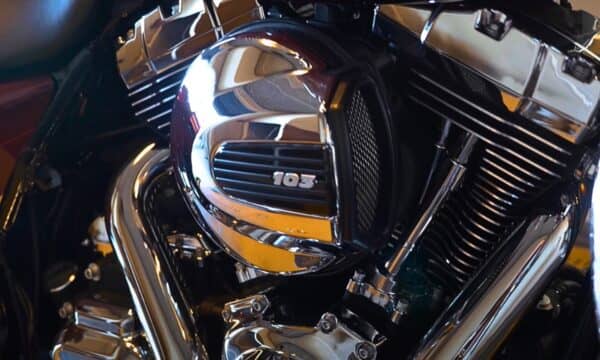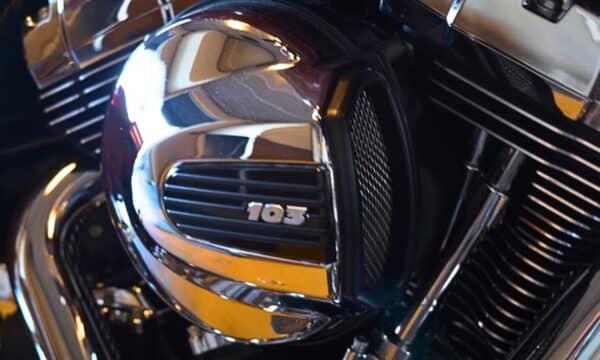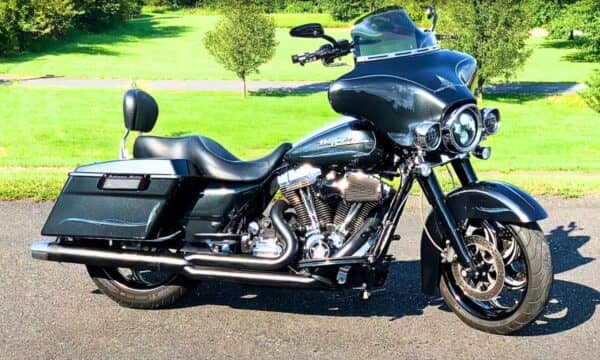If you’re looking for it, is the Harley 103 a good engine? Then you already know!

The best engine always depends on your own needs and preferences. But the question is, is 103 suitable?
SO! In this article, we will dive into whether the 103 is a good engine.
Let’s get started!
Is the Harley 103 a Good Engine?
Yes, the Harley 103 engine is good enough as compared to the previous models of engines used in Harley. But there are still several problems with this engine. But still you could fix these problems at your own.
The Harley-Davidson 103 engine, also known as the Twin Cam 103, is a popular engine that was introduced by Harley-Davidson in 2011.
It’s a 1,690cc V-twin engine that was designed to offer more power and an improved riding experience compared to its predecessors.
Related: Harley Davidson 107 Problems
Performance
The 103 engine offers a noticeable bump in power compared to the older 96 cubic-inch engine. Riders often report a smoother, more responsive throttle and better acceleration.
Reliability
Harley-Davidson engines, in general, are known for their durability and longevity. The 103 is no exception.
With proper maintenance, these engines can last for hundreds of thousands of miles.
Sound
One of the remarkable things about a Harley-Davidson motorcycle is its sound. The 103 engine delivers that classic Harley rumble that many riders love.
Fuel Efficiency
The 103 is reasonably efficient for its size, especially when paired with Harley’s six-speed transmission.

Cooling
The 103 engine, like other Twin Cam engines, is air-cooled. While it maintains the classic Harley look, it can lead to the engine running hotter in stop-and-go traffic or on sweltering days.
Later models introduced a partial liquid-cooling solution for the heads to address this.
The Harley 103 is a robust and reliable engine that offers a good balance of power and performance.
Like any engine, it has its quirks and potential issues, but with proper care and maintenance, it can offer a satisfying and long-lasting riding experience.
However, individual experiences may vary, so it’s essential to do thorough research and even test-ride a bike with a 103 engine to see if it’s the right fit for you.
How Long Does Harley 103 Last?
The Harley-Davidson 103 engine, commonly found in many of the company’s touring models, is known for its reliability and longevity when properly maintained.
On average, with regular service and preventive maintenance, a Harley 103 engine can last between 80,000 to 100,000 miles.
However, some riders have reported crossing the 200,000-mile mark with proper care.
Like any engine, its lifespan is influenced by factors such as riding conditions, maintenance habits, and the quality of parts used.

Common Harley 103 Engine Problems
The Harley 103 engine, like many engines, has its own set of common problems that owners and mechanics should be aware of.
Here’s a detailed look at some of the issues:
Related: Milwaukee 103 Vs 107 Engine
1. Hot Start Problem
The hot start problem is a common issue faced by many Harley 103 engine owners.
This problem arises while the engine runs for a while and then shuts off and struggles to start back up when it’s still hot.
Causes
1. When the components get too hot, their efficiency drops, which makes it harder to perform the function of starting the engine.
2. A weak battery might not provide enough power to turn over a hot engine. Heat can reduce the efficiency of the battery, and if it’s already weak, it might not be able to provide the necessary cranking amps.
3. The Harley 103 engine has a high compression ratio. When the engine is hot, the compression can increase, which makes it harder for the starter to turn the engine over.
Solutions
1. Firstly, ensure that the battery is in good condition and replace it if it’s necessary.
2. Install a high-torque starter that can handle the increased compression of a hot engine.
3. Always allow the engine to cool down for a few minutes before attempting to restart.
2. Worn Crank Problem
The Harley 103 engine’s crankshaft can experience wear and tear, leading to a range of performance issues.
Causes
1. Excessive vibration can lead to premature wear of the crankshaft and its bearings.
2. Not changing the oil regularly or using low-quality oil can lead to inadequate lubrication, causing wear.
3. In some cases, the crankshaft might have manufacturing defects that lead to premature wear.
Solution
1. Regular maintenance and oil changes with high-quality oil can solve the issue.
2. Use engine stabilizers or dampers to reduce vibration.
3. If the crankshaft is severely worn, it might be time to replace it.
3. Cracking Cylinder Heads
Cracked cylinder heads can be a serious issue, leading to coolant leaks, poor performance, and even engine failure.
Causes
1. Overheating is the primary cause of cracked cylinder heads. When engine gets too hot, the metal can weaken and crack.
2. Dropping or mishandling the cylinder head during maintenance can also cause cracks.
Solutions
1. Regularly check and maintain the cooling system to prevent overheating.
2. Ensure the air-fuel mixture is correct and that the ignition timing is set properly to prevent detonation.
3. Handle cylinder heads with care during maintenance and installation.
4. Engine Knocking
Engine knocking, often referred to as “pinging” or “detonation,” is a sound that you’ll hear when the air-fuel mixture is detonating in more than one place at a time.
Several factors can cause it:
Low-Octane Fuel
The Harley 103 engine requires a specific octane rating for its fuel. Using a lower octane than recommended can cause premature ignition of the fuel, leading to knocking.
Carbon Deposits
Over time, carbon can accumulate on the cylinder walls and piston tops. These deposits can create hot spots, which can ignite the air-fuel mixture prematurely.
Overheating
If the engine is running hotter than it should be, it can lead to knocking. It can be due to issues like a malfunctioning cooling system or improper oil levels.
In order to address engine knocking, you should ensure you’re using the right octane fuel, regularly service the bike to prevent carbon buildup, and ensure the cooling system is functioning correctly.
5. Ignition Problems
Ignition problems can prevent the engine from starting or cause it to run poorly.
Here are some causes for ignition problems:
Faulty Spark Plugs
Spark plugs can become fouled or wear out, leading to weak or no spark.
Bad Ignition Coil
The ignition coil is responsible for boosting the battery’s 12 volts to a high voltage, which is necessary to spark the fuel. A malfunctioning coil can lead to a weak or no spark.
Damaged Ignition Wires
These wires carry the high voltage from the coil to the spark plug. If they’re damaged or corroded, it can lead to ignition problems.
6. Fuel Injection Problems
Fuel injection problems can lead to a range of issues, from poor performance to the engine not starting. Some common fuel injection problems include:
Clogged Injectors
Over time, fuel injectors can become clogged, especially if low-quality fuel is used. It can lead to poor fuel spray patterns and reduced performance.
Faulty Fuel Pump
Fuel pump is responsible to deliver fuel from the tank to the engine. If it’s malfunctioning, it can lead to inadequate fuel delivery.
Bad Fuel Pressure Regulator
The regulator maintains the correct pressure in the fuel system. If it’s faulty, it can lead to either too much or too low fuel being delivered to the engine.
7. Leaking Coolant
Coolant leakage is a problem that can affect any engine, not just the Harley 103.
Coolant is essential for maintaining the engine’s temperature, preventing it from overheating.
A leak coolant can lead to reduced cooling efficiency, which can subsequently cause the engine to overheat.
Causes
1. One of the most common causes of coolant leaks in the Harley 103 engine is the failure of gaskets. Over time, gaskets can be damaged, leading to leaks.
2. The radiator, which holds the coolant, can be damaged or have cracks or holes over time, leading to leakage.
Solutions
1. Regularly inspect the gaskets, radiator, and hoses for signs of wear or damage.
2. Replace the damaged components immediately.
3. Ensure that the coolant is topped up to the recommended level.
8. Fuel Delivery Problems
Fuel delivery problems can lead to the engine not receiving the right amount of fuel, causing it to run lean or rich.
It can affect the engine’s performance, fuel efficiency and can even lead to engine damage.
Causes
1. Over time, the fuel filter can become clogged with debris, restricting the flow of fuel to the engine.
2. The fuel pump is responsible for delivering fuel from the tank to the engine. A malfunctioning pump can lead to inadequate fuel delivery.
3. The fuel injectors spray fuel into the combustion chamber and can become clogged or malfunction, leading to uneven or inadequate fuel delivery.
Solutions
1. Regularly replace the fuel filter to ensure it’s not clogged.
2. Check the fuel pump for signs of wear or malfunction and replace it if necessary.
3. Clean or replace faulty fuel injectors to ensure optimal fuel delivery.
FAQ
How much power does a 103 Harley have?
The Harley-Davidson 103 engine produces approximately 100 lb-ft of torque and 103 hp, offering robust power and performance for riders.
How many miles does a Harley 103 engine last?
A well-maintained Harley-Davidson 103 engine can last over 100,000 miles, with some riders reporting even longer lifespans with proper care and regular service.
How many cc is a Harley 103?
The Harley-Davidson 103 engine is approximately 1,690cc (cubic centimetres) in displacement.
Wrapping UP
The Harley-Davidson 103 engine, with its 1,690cc displacement, is renowned for its robust power and torque.
Reports of it lasting over 100,000 miles are a testament to Harley’s engineering prowess.
Its longevity and performance make it a favoured choice among many riders. The Harley 103 is a good engine and a reliable powerhouse in the motorcycle world.
You may love to read!
Harley Davidson 96 Engine Specs

Ahtsham Younas is a passionate blogger and content writer. He loves to ride motorcycles and learn the mechanical process behind the motorcycles.
He has been writing articles in the motorcycle industry since 2019 and has learned many things about motorbike niches.


